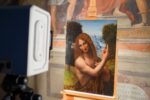Texture and liquidity
Texture può essere tradotto con i termini “tessitura”, “trama”, “consistenza”. Texture è ciò che, solo apparentemente, sfugge al concetto di ineffabilità.
Comunicato stampa
Texture is strongly related to such concepts as consistency, surface, structure.
The concept of Texture can be easily perceived and codified, apparently. Texture is the element that catches the viewer's gaze, her/his retina, and since the eye is the primary element in the relationship viewer/artwork, the texture becomes a determinant factor in the observation process.
Looking at an artwork and its consistency, the viewer's hand can not do much, her/his eyes must develop a tactile quality.
In the virtual age, with the new technologies and with the new and sophisticated materials, the osmosis between the digital display and the artwork's surface generates a decrease of the materic element and subsequently it takes a new aspect: slick, liquid, flat. The artist is therefore tempted to generate an elusive object. To what extent is the artist worried to be too much invasive in her/his artwork?
Zygmunt Bauman in Liquid Fear states: "The most technologically equipped generation in human history is the generation most haunted by feelings of insecurity and helplessness."
A possible condition for the human being is to feel overwhelmed by technology, by anxiety to dominate, collect and classify every information.
How does the artist react to Bauman's statement? The artist perfectly interprets the present and in a certain way predicts the future: how does she/he react to that huge technological equipment?
To what extent is the artist assaulted by the fast and "Liquid modernity" and tempted to escape from himself? Is it possible to not obbey to that "liquid" aesthetic and be at the same time able to read and communicate the contemporaneity? Can the artist put herself/himself in the middle?
The project Texture and Liquidity tends to analyze nine artistic positions, on one hand putting a light on the handcrafted aspect, through the use of paint, resins, gauzes, concrete etc.; on the other hand are considered all the possible conceptual translations, like the possibility of an ethereal, antimateric interpretation of the concept of Texture.
Putting aside the primary relevance of the contents and of the communicative origin, this project focuses the attention on the idea of Texture that each artist has pursued, remembering Friedrich Hegel quote: "There is nothing deeper than what appears on the surface".
Vincenzo Della Corte
Texture può essere tradotto con i termini "tessitura", "trama", "consistenza". Texture è ciò che, solo apparentemente, sfugge al concetto di ineffabilità.
Texture è quell'accadimento materico che determina una sensazione, nell'osservatore, innanzitutto retinica, e se l'occhio è il medium primario attraverso il quale si genera la relazione
osservatore/opera, la Texture diventa l’elemento determinante all'interno del processo di osservazione.
Di fronte ad un'opera e di fronte alla consistenza di essa, la mano dell'osservatore poco puo' fare, è l'occhio a dover sviluppare il tatto.
Nell'era virtuale, delle nuove tecnologie e con l’avvento di nuovi e sofisticati materiali, l'osmosi tra lo schermo digitale e la superficie dell'opera genera un inesorabile processo al deficere dell'elemento materico ed essa, quindi, assume nuova sembianza: liscia, piatta, liquida. In agguato è la tentazione costante di generare un oggetto inafferrabile. In agguato è forse il timore da parte dell’artista di un intervento eccessivo e di essere troppo presente? A questo proposito, Zygmunt Bauman, nel suo scritto "Paura liquida" afferma: "La generazione meglio equipaggiata tecnologicamente di tutta la storia umana è anche la generazione afflitta come nessun'altra da sensazioni di insicurezza e di impotenza". Il rischio dell’essere umano è di sentirsi sopraffatto dalla tecnologia, dal bombardamento quotidiano di informazioni, dall’ansia di dominare, recepire e catalogare tutto.
E l’artista come si pone rispetto all’autorevole ma sfidante affermazione di Bauman?
L’artista, che legge il presente in anticipo e che quindi in un certo senso prevede il futuro, come reagisce rispetto a questo ingombrante equipaggiamento tecnologico?
Fino a che punto la “modernità liquida”, fulminea, assale l'artista e lo induce nella tentazione di scappare da sé stesso? E’ possibile non obbedire ciecamente a questa liquidità senza rischiare l’accusa di non essere al passo con l’estetica corrente, di essere incapace di leggere il presente? Può l’artista porsi “nel mezzo”, dal punto di vista estetico se non persino contenutistico?
Il progetto Texture and Liquidity tende ad analizzare, alla luce di quanto sopracitato, dieci diverse posizioni, da un lato mettendo in luce un'attitudine puramente manuale, artigianale, tramite l'uso di tele, pittura, resine, garze, cementi etc; dall'altro, considerando tutte le possibili declinazioni concettuali. D'altronde come potremmo reagire stupiti di fronte ad un'eventuale lettura antimaterica, eterea della Texture?
Accantonando, in prima istanza, l'intenzione contenutistica, o meglio, la scaturìgine comunicativa, questo progetto pone quindi l'attenzione sull'idea di Texture che ogni artista ha perseguito a proprio modo, memore del messaggio di Friedrich Hegel: "Non c'è niente di più profondo di ciò che appare in superficie."
Vincenzo Della Corte



